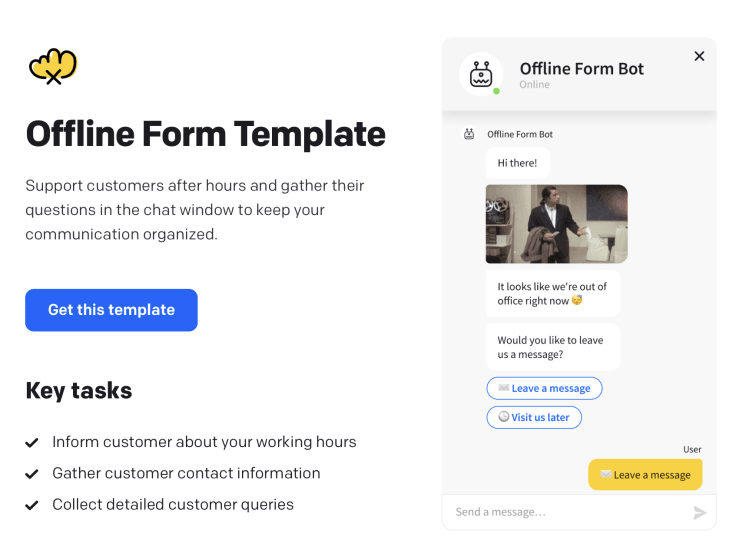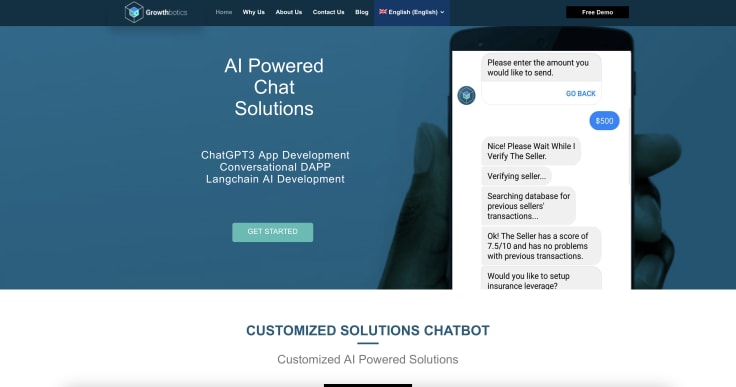Showing top 0 results 0 results found
Showing top 0 results 0 results found

We are living in the digital age. Banking processes that were once completed in-person have now shifted remotely, like depositing checks, transferring funds, and paying bills.
Visiting branch locations or calling a customer service line for questions are outliers, especially as customers no longer want to wait hours for a live agent. Instead, digital apps and chatbots have moved to the front stage.
This shift in consumer behavior calls for a robust banking chatbot, which can help facilitate a positive working relationship with both current and prospective customers.
In this guide, I’ll outline everything you need to know about chatbots in banking, including the benefits, common applications, and the best banking chatbots on the market.
What are banking chatbots?
A chatbot is a computer program that uses natural language processing (NLP) to facilitate a human-like conversation. This piece of artificial intelligence (AI) uses machine learning (ML) to continuously adjust responses based on prior interactions.
Unlike a team of human customer support agents, banking chatbots are available 24/7, supporting positive customer service interactions, cross-selling strategies, and lowering your operating costs.
The benefits of chatbots in banking
A chatbot for financial institutions can be an indispensable resource, both for your internal team and external customers.
Here are six ways your financial institution can benefit from banking chatbots:
1. Personalize customer interactions
Customer service shouldn’t be bland. After all, each customer is unique. Without personalized customer interactions, your customers could feel like just another number on your roster. This can lead to high turnover ratios and a poor brand image.
By personalizing customer interactions, you can meet customer expectations regarding response times and answer quality. With natural language understanding and 24/7 availability, you can meet the demands of a diverse customer base, including night owls and overseas customers.
Additionally, many chatbots have multilingual capabilities. Offering customer service in numerous languages can be a great competitive advantage, allowing you to attract customers from around the globe.
2. Detect and prevent fraud
Fraud plagues the banking sector, with recent studies showing that 35% of companies reported over 1,000 fraud attempts during 2023. Even more surprising is that 61% of companies reported an increase in fraud attacks on consumer accounts, while 54% of companies reported a rise in business account fraud attempts.
Just one successful fraudulent attack could have serious implications on your brand image and profitability. Banking chatbots can help you reduce your risk of fraud by analyzing customer spending habits and detecting unusual payments. Any detected outliers are promptly reported to your customer for verification, safeguarding you and your customers.

If you're looking for a secure solution, choose one with no or little dependencies. We develop our standalone AI, so ChatBot doesn't rely on third-party providers like OpenAI, Google Bard or Bing AI.
3. Manage high levels of transactions
It’s common for growing financial institutions to receive multiple requests at once. Instead of placing these customers in a queue for live customer service agents, you can inquire about their requests through a conversational chatbot.
Conversational chatbots can answer basic questions about balances, transactions, and due dates, eliminating a bottleneck for your live customer service agents. This helps you meet customer expectations timely, even during periods of high inquiries.
4. Customer education
Financial products can be difficult to understand, especially when trying to find information through mobile banking apps. Chatbots in the banking industry are designed to educate customers about available financial solutions and answer any relevant questions.
Educating your customers makes you more likely to position your business as a trusted resource in the banking realm.
For example, let’s say a customer asks, “What type of bank accounts can I open?” Your chatbot can break down each account type, helping the customer make the right selection.
5. Cash flow support
Chatbots in the banking industry are crucial tools for supporting cash flow. From reminding customers about upcoming payments to decreasing your virtual assistant costs, banking chatbots can improve your bottom-line profitability.
Prioritizing cash flow is especially important as your business scales and takes on more customers. Banking chatbots grow alongside you without restrictions on processing capabilities, allowing you to fully leverage digital transformation.
6. Built-in upsell and cross-sell strategies
Most financial institutions offer a variety of financial products to customers, from different account types and credit cards to loans and investment options. Banking chatbots can be customized to include built-in cross-sell and upsell strategies.
For example, your chatbot technology might be programmed to evaluate a customer’s spending habits and transaction history to suggest new financial products, like a lower-interest credit card or a short-term personal loan.
Start a free 14-day trial to see what our ChatBot can do.
Banking chatbot applications
There are numerous chatbot use cases. Let’s explore some of these in more detail:
1. Conduct essential banking activities
With artificial intelligence banking technology, customers no longer need to wait in long queues to get basic questions answered. Instead, they can receive quick and reliable services instantly with banking chatbots.
In addition, banking chatbots can automate basic tasks, like moving money between accounts and paying monthly bills. This allows your customers to fully leverage the power of mobile banking.
Moreover, as loud budgeting gains popularity, a term used to describe the open discussion of a person’s financial situation, banking chatbots can provide customers with a breakdown of financial activities. This includes spending habits, account balances, and average monthly bills.
2. Answer FAQs
Customers shouldn’t have to wait for hours on the phone to answer common questions, including:
- What is my current balance?
- What time do branch locations open?
- How can I schedule an appointment?
- What is the interest rate on my loan?
- How do I apply for a credit card?
- What loan options are available?
- How do I open a savings account?
A chatbot for the banking industry can answer these questions immediately, regardless of the time.
3. Provide customer support
Customer support takes many forms, not just issues. In fact, a proactive customer support function keeps your customers in the loop at all times. Banking chatbots can send customers notifications about payment reminders, transfer requests, current charges, posted transactions, and credit score updates.
When customers enable push notifications, they no longer need to log in to their account and search for the information. They have notifications delivered instantly by banking chatbots.

4. Identify and resolve suspicious activity
Companies that commit to data security build a brand image of trust and dependency. With a chatbot working in the background identifying and resolving suspicious activity, you reduce the risk of fraudulent hacks and attacks.
For example, your chatbot can ask customers to verify a suspicious transaction before it’s posted. This requires no review from your internal team and allows your business to continue operating without any disruptions or timely customer service inquiries.
5. Facilitate financial product applications
Most financial product applications are conducted through the internet. Your banking chatbot can facilitate the process from start to finish without any human intervention needed.
For example, your chatbot can suggest the best product based on the customer’s preferences and guide the customer through each step of the application process. This customized approach builds customer satisfaction and helps with your upsell and cross-sell strategies.
6. Promote reviews and feedback
Reviews and feedback are crucial components of building a strong brand image. Banking chatbots make it simple to collect customer feedback, whether bad or good. Short-form and long-form surveys can be conducted through your chatbot, allowing you to harvest important information.

Make sure to try out our offline form template. When enabled on your site, it will inform customers that your team is offline and let them leave messages in the chat window.
The fundamentals of banking chatbots
Effective and efficient banking chatbots should include a few core components, including:
1. Conversational
At the most basic level, your banking chatbot needs to be conversational. Customers should feel like they are communicating with a human in terms of syntax, grammar, and punctuation. Without a personal feel to your chatbot, customers can get frustrated, which generates a poor experience.
The good news is that most chatbots in banking use natural language understanding to stimulate a human-like conversation. Nevertheless, conversational banking should be a fundamental component built into your chatbot.
2. On-brand
Your chatbot is an extension of your company, so its features need to align with your branding. For example, your chatbot should understand your policies regarding late fees, due dates, and other core components.
Without the proper back-end training, your chatbot could distribute inaccurate information, leading to a mismatched brand image and confused customers. Before your banking chatbot goes live, be sure that all of the necessary back-end information is updated and accurate.
3. Transactional
Implementing a banking chatbot should lead to cost-saving opportunities. After all, you are alleviating a portion of the burden on your live customer support agents. When looking for a banking chatbot, understand the expected cost savings.
- Will you be able to increase revenue from cross-selling strategies?
- How about decreasing the costs of outsourced customer service agents?
Set benchmarks for your cost savings and be sure to follow up on actual results. If your expected and actual results greatly differ, it might be time to take a deeper dive into the fundamentals of your chatbot and make adjustments.
4. Informative
Another core competency your chatbot should have is value. Answers provided by chatbots shouldn’t be generic. Instead, they should be customized to fit the specific needs of the inquiry or customer.
Let’s say a customer asks about the due date of the credit card bill. If your chatbot spits out a generic answer, like “Bill due dates vary based on when your credit card was opened,” it’s not very helpful to your customer. Your chatbot needs to give specific and accurate information, such as, “Your bill is due on May 15.”
5. Secure
The data and information transmitted between your chatbot and the customer need to be secure. Sensitive information, like a customer’s address or account number, is often found within the chatbot.
A fundamental feature to consider is using a chatbot that is not dependent on third-party providers. When all data is processed and hosted within the chatbot platform, you reduce the risk of sensitive customer information leaking to unauthorized parties.
6. Integrated
Your chatbot shouldn’t default customers to an entirely different portal. Instead, it should be an extension of your mobile app or website, operating seamlessly in the background. Customers who need to use a different platform could be hesitant about the chatbot's authenticity.
Make sure your chatbot is integrated into your business’ existing tech stack. This allows the chatbot to access important systems, like your customer support database and your knowledge database to provide valuable information to customers.
7. Analytical
Chatbots need to have more features than just basic question answering. In fact, to fully leverage cross-sell and upsell strategies, your banking chatbot should have an analytical component. It should be able to gather information from customers and compile it into reports for your management team to review.
For example, if dozens of customers report the same issue in the mobile app, your development team can swiftly solve the issue. Additionally, the consistent analytical data your chatbot produces can help build your competitive edge in the area of products and services.
8. Continuously improving
Although most chatbots will use some form of machine learning, always double-check for continuous improvement. The data your chatbot produces should be used to further develop your system and provide value to customers.
Continuous improvement makes your system more efficient and effective over time, bolstering your value proposition to customers. However, be sure that the improvements and the adjustments the chatbot makes align with your brand image and chatbot expectations.
For example, a chatbot could pick up on a lax tone from customers. This might not present your business as an authoritative and trustworthy source. As a result, you may need to adjust your chatbot improvements to realign your goals and strategies.
7 of the best banking chatbots
The popularity of finance chatbots means you have numerous providers to choose from. When selecting a provider, keep the fundamentals of chatbots in mind. You want to choose a chatbot provider that offers you the most advantages and can scale alongside you.
Nevertheless, here’s a breakdown of the top finance chatbots for banks and personal finance:
1. ChatBot

ChatBot makes the list of the best banking chatbots because of the back-end security features. ChatBot processes and hosts data only within the ChatBot platform, with no dependencies on third-party providers. In addition, ChatBot provides 24/7 customer support with quick and accurate AI-generated answers specific to the banking industry.
2. TARS

TARS is considered one of the best banking chatbots because of its extensive conversion funnel options. There are hundreds of chatbot templates to choose from, a simple set-up process, and different reports to evaluate data.
3. Haptik

Haptik is a great banking chatbot for businesses looking for detailed analytics. Additionally, this chatbot provider has a comprehensive back-end customer support function, which is beneficial for streamlining customer experience and prioritizing customer needs.
4. Kasisto

Kasisto uses machine learning to make realistic recommendations to clients, leveraging cross-sell and upsell strategies. In addition, Kasisto is able to answer basic service requests and has multiple channels for communication, like text, touch, and voice commands.
5. Kore.ai

Kore.ai makes the list because of its focus on efficiency. This provider has a comprehensive reporting function, allowing you to track and analyze customer inquiries. In addition, Kore.ai integrates with over 30 third-party programs, giving you the ability to use a central system.
6. AlphaChat

AlphaChat is a finance-focused chatbot with multiple language options, extensive reporting and analytics, and customizable chatbot answers. Like many of the other banking chatbots, AlphaChat does have integration capabilities with other business apps.
7. Growthbotics

Growthbotics shifts its attention to the personal finance realm, making predictions about loan applications. Growthbotics is great for institutions looking to facilitate loan applications and the customer onboarding process through chatbots.
Banking chatbot implementation best practices
When implementing your banking chatbot, you should follow a few best practices.
1. Know what your customers want
You could implement the best chatbot on the market, but if it doesn’t meet customer expectations, it will have little to no impact on your value proposition and bottom line. Before implementing a chatbot, fully understand what your customers are looking for.
Do they want to be able to track their financial habits? How about having 24/7 support to customer support? Understanding your audience's wants gives you a baseline for creating your chatbot features and fundamentals.
Start by gathering demographic information, including the average age of your customer base, the types of support inquiries you’ve dealt with in the past, and the main features customers request.
Remember, your customer demands can change after implementing your chatbot, so don’t be afraid to adjust your value proposition along the way.
2. Align your chatbot with your brand voice
The conversational language a millennial uses greatly differs from a baby boomer. If you’re a fintech startup looking to attract younger customers, your brand voice should cater to that target market.
Your chatbot should be an extension of your overall brand, following the same principles as your physical locations, website, phone support, and other marketing channels. However, don’t make your brand voice too relaxed. Your chatbot should be knowledgeable and authoritative but friendly and approachable.
Before you roll out your new chatbot, test out your brand voice by asking questions in different ways. You should be able to understand how your chatbot will handle different interactions. Make adjustments if you notice any responses that don’t associate with your brand voice.
3. Regularly review information
AI chatbots use machine learning to continuously adapt to your target market. This means that your brand voice and processes can begin to shift away from your goals. By regularly reviewing and testing your chatbot, you can catch any shortcomings and make the necessary adjustments.
Regular information review and feedback can also help you pinpoint inefficiencies in your chatbot. Make it a priority to review your chatbot on a monthly basis. This process should include analyzing customer feedback, fixing any issues, and confirming that all functions are optimized.
4. Optimize live agents and chatbots
As helpful as banking chatbots can be, they aren’t a substitute for live agents. From breakdowns in communication to complex problems, it’s crucial to have live agents ready to jump in and assist customers. Before you implement a banking chatbot in your business, understand how you will optimize the balance between live agents and chatbots.
Will you still have live agents 24/7? Will you reduce the hours of your live agents to normal business hours (9-5)? Can you reduce the number of live agents you have? These are all important questions to answer before implementing a banking chatbot in your organization.
Successful implementation of banking chatbots will optimize your cost savings while still providing your customers with the needed support. Take the time to dig deep into how your banking chatbot will alter the dynamic of your customer support function.
5. Prioritize security and compliance
The rise of technology has prompted many regulatory agencies to expand their reach regarding safeguarding consumer information. This makes it essential to understand the data privacy regulations that your business must follow.
At the most basic level, communication between customers and your chatbot needs to be secure at the most basic level. This might involve having a firewall, a secure server, and an integrated chatbot into your central system to diminish unsafe connections.
Additionally, understand how different financial institution security regulations apply to chatbots. What customer information can you store? How can you use the data harvested from customers? These areas are crucial to maintaining compliance with regulatory agencies.
Summary
The shifts in customer demands make the future of chatbots bright. Whether your organization is considering adding a banking chatbot for the first time or you’re looking to switch providers, our team at ChatBot has you covered.
Our chatbot is designed for the banking industry, giving quick and accurate AI-generated answers to customer questions. Not to mention that our platform has a no coding chatbot setup and operates independent of third-party providers, safeguarding sensitive information transmitted through the chatbot.
If you still have questions about what a banking chatbot looks like for your organization, check out our FAQ section below or reach out to a team member for a customized demo. Don’t let competitors pass you up. Now is the time to add a chatbot to your business, bolstering your sales function, brand image, and customer service.
Create your banking chatbot in minutes with our AI ChatBot 🤖
FAQs
How do banking chatbots work?
Banking chatbots use artificial intelligence and machine learning to respond to customer queries. By using natural language processing, the chatbot facilitates a human-like conversation with a customer.
Unlike human support agents, banking chatbots are available 24/7, allowing customers to bypass long wait times. For any tasks a banking chatbot can’t handle, it will refer the customer to a live agent.
What services can banking chatbots offer?
Banking chatbots offer a variety of services designed to fit the needs of both you and your customers. However, most chatbots focus on answering basic questions like payment due dates, available financial products, and customer spending habits.
Some chatbots extend beyond answering basic questions, facilitating loan applications, transferring funds, and sending money. Your financial institution's needs will determine which chatbot services are most beneficial.
Are chatbots in banking secure?
Yes, banking chatbots are a secure form of communication for your customers. If you are concerned about security, use a chatbot that does not rely on third-party providers. This ensures all data is kept in-house and is fully secure from external threats.
Can chatbot technology handle complex customer interactions?
Chatbots aren’t designed to handle complex customer requests and inquiries. For any question or request the chatbot can’t handle, the customer will be referred to a live agent for additional assistance.
Nevertheless, chatbots have come a long way over the past few years, meaning they can handle most customer requests.
How does artificial intelligence prevent and detect fraud?
Artificial intelligence uses machine learning to evaluate customer spending habits and pick out any suspicious activity. The chatbot will then send a request to the customer to verify the transaction’s legitimacy.
If the transaction is fraudulent, the chatbot can freeze the customer’s account and bring in a live agent to evaluate the situation. Outsourcing fraud prevention and detection to a chatbot results in more accuracy and timeliness when it comes to suspicious activity.
How do banking chatbots integrate with existing infrastructure?
Banking chatbots are designed to work seamlessly with your existing infrastructure. In fact, full integration is usually required to give the chatbot access to important information, like transaction history, account information, and past support tickets.



